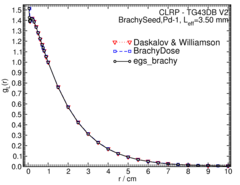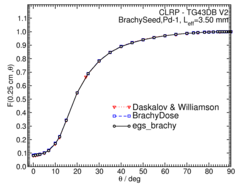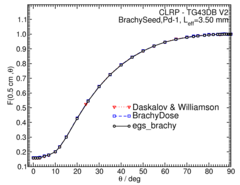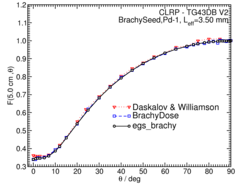
Source Description:
Seed dimensions for the BEBIG GmbH 103Pd seed are taken from the paper by Daskalov and Williamson 1. This source consists of 103Pd uniformly distributed throughout a 3.50 mm long ceramic cylindrical annulus of alumina (Al2 O3 , 2.88 g.cm-3) with inner and outer diameters of 0.250 mm and 0.60 mm, respectively. For the purpose of these calculations the mass of 103Pd present in the alumina is assumed to be negligible. Within the core is a 3.50 mm long gold rod with a diameter of 0.20 mm (Note: the previous version of this database mistakenly modelled this as silver). The core is encapsulated in a titanium tube with 0.050 mm thick walls and 0.80 mm outer diameter. The end welds are slightly concave and have a thickness of 0.435 mm in the middle. End welds are modelled using a 0.40 mm Ti hemisphere overlapped with a 0.806 mm air sphere with its center shifted by 0.846 mm relative to the Ti sphere. The overall source length is 4.56 mm and the active length is 3.50 mm. The cylindrical source element is free to move 0.050 mm radially and a negligible amount along the seed axis. However, for our simulations we assume that it is always placed at the source's center. The mean photon energy calculated on the surface of the source is 20.50 keV with statistical uncertainty < 0.01%.
Dose-Rate Constant - Λ :
Dose-rate constants, Λ , are calculated by dividing the dose to water per history in a (0.1 mm)3 voxel centered on the reference position, (1 cm,Π/2), in a 30x30x30 cm3 water phantom, by the air-kerma strength per history (scored in vacuo). As described in ref. 2, dose-rate constants are provided for air-kerma strength calculated using voxels of 2.66x2.66x0.05 cm3 (WAFAC) and 0.1x0.1x0.05 cm3 (point) located 10 cm from the source. The larger voxel size averages the air-kerma per history over a region covering roughly the same solid angle subtended by the primary collimator of the NIST WAFAC 3, 4 used for calibrating low-energy brachytherapy sources and is likely the most clinically relevant value. The small voxel serves to estimate the air-kerma per history at a point on the transverse axis and includes a small 1/r2 correction (0.5%)2. egs_brachy and BrachyDose MC uncertainties are statistical uncertainties only (k=1). (Note: Results from Taylor and Rogers6 for this seed mistakenly included a cylindrical shell of water around the seed in air-kerma calculations, and as well as the gold marker is modeled with silver material. This increased their DRC value).
* Taylor-Rogers values differ from the current values 5 due to changes in how the seed is modelled.
Radial dose function - g(r):
The radial dose function, g(r), is calculated using both line and point source geometry functions and tabulated at 36 different radial distances ranging from 0.05 cm to 10 cm. Fit parameters for a modified polynomial expression are also provided 7. The mean residual deviation from the actual data for the best fit is < 0.17%.
| Fitting coefficients for g L (r) = (a0 r-2 + a1 r-1 + a2 + a3r + a4r2 + a5 r3) e-a6r | |||
| Fit range | Coefficients | ||
| r min (cm) | r max (cm) | ||
| 0.05 | 10.00 | a0 / cm2 | (1.816+/-0.017)E-03 |
| a1 / cm | (-4.67+/-0.04)E-02 | ||
| a2 | (1.7476+/-0.0026)E+00 | ||
| a3 / cm-1 | (1.86+/-0.19)E-01 | ||
| a4 / cm-2 | (-4.38+/-0.08)E-02 | ||
| a5 / cm-3 | (3.19+/-0.08)E-03 | ||
| a6 / cm-1 | (6.17+/-0.09)E-01 | ||
Anisotropy function - F(r,θ):
Anisotropy functions are calculated using the line source approximation and tabulated at radii of 0.1, 0.15, 0.25, 0.5, 0.75, 1, 2, 3, 4, 5, 7.5 and 10 cm and 32 unique polar angles with a minimum resolution of 5°. The anisotropy factor, φan (r), was calculated by integrating the solid angle weighted dose rate over 0° ≤ ϑ ≤ 90° .
Tabulated data:
Tabulated data are available in .xlsx format: Excel
References:
1. G. M. Daskalov, J. F. Williamson, Monte Carlo-aided dosimetry of the new Bebig IsoSeed 103Pd interstitial brachytherapy seed, Med. Phys., 28 , 2154 - 2161, 2001.
2. R. E. P. Taylor et al , Benchmarking BrachyDose: voxel-based EGSnrc Monte Carlo calculations of TG-43 dosimetry parameters, Med. Phys., 34 , 445 - 457, 2007.
3. R. Loevinger, Wide-angle free-air chamber for calibration of low-energy brachytherapy sources, Med. Phys., 20 , 907, 1993.
4. S. M Seltzer et al , New National Air-Kerma-Strength Standards for 125I and 103Pd Brachytherapy Seeds, J. Res. Natl. Inst. Stand. Technol., 108 , 337 - 358, 2003.
5. H. Safigholi, M. J. P. Chamberland, R. E. P. Taylor, C. H. Allen, M. P. Martinov, D. W. O. Rogers, and R. M. Thomson, Updated of the CLRP TG-43 parameter database for low-energy photon-emitting brachytherapy sources,to be published (Current Calculation). 6. Taylor, D. W. O. Rogers, An EGSnrc Monte Carlo-calculated database of TG-43 parameters, Med. Phys., 35 , 4228-4241,2008.
7. R. E. P. Taylor, D. W. O. Rogers, More accurate fitting of 125I and 103Pd radial dose functions, Med. Phys., 35 , 4242-4250, 2008.



